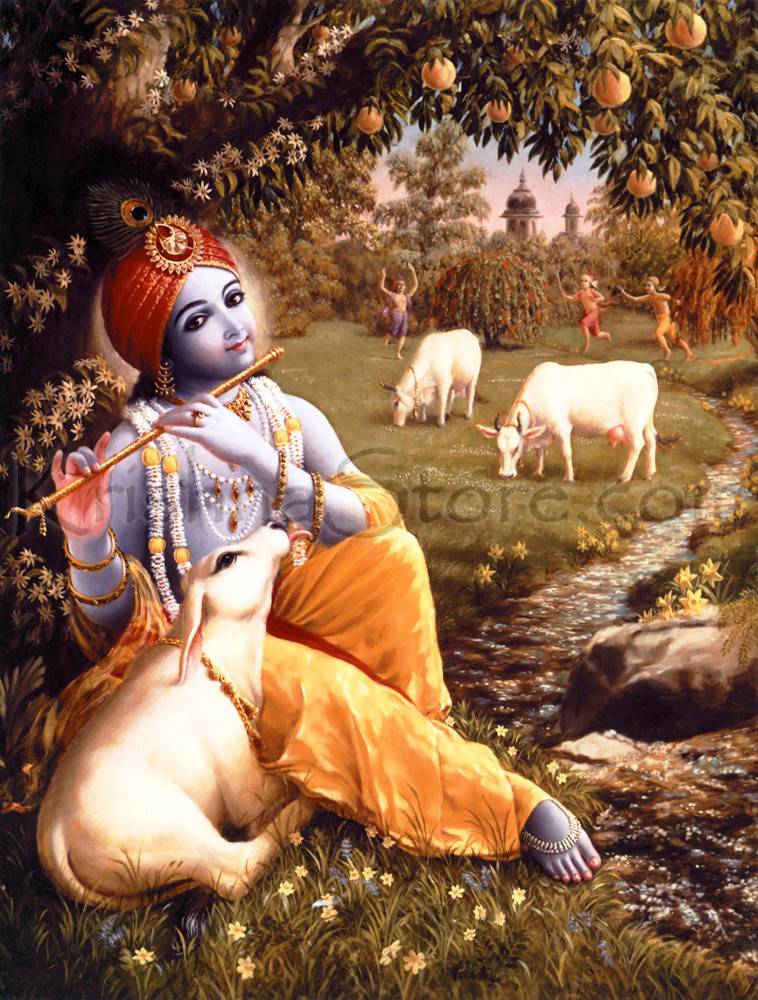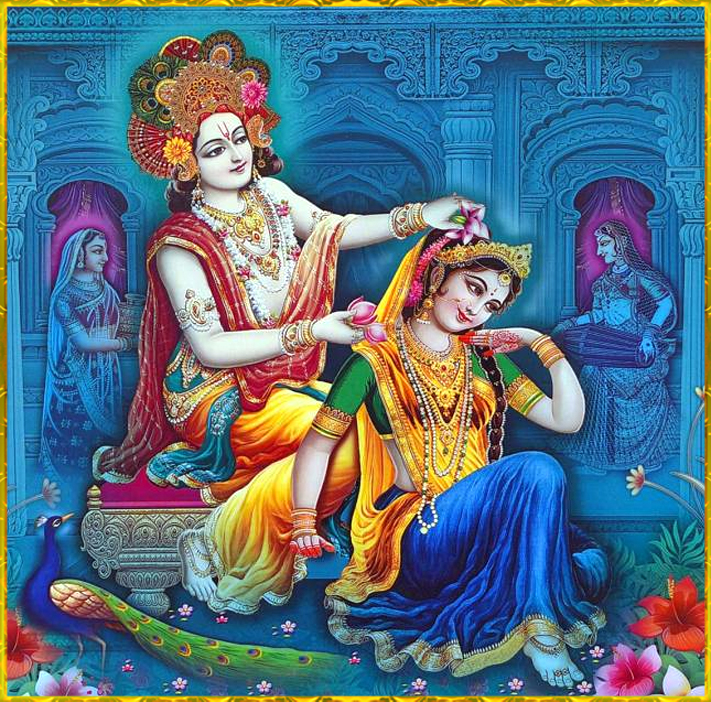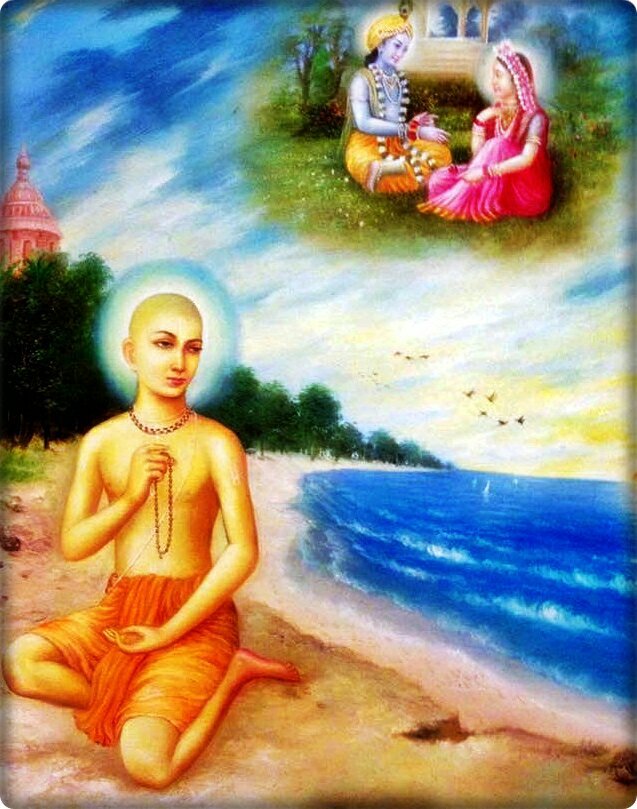Mahanidhi Madan Gopal Das
For the last 500 years, Gaudiya Vaisnava acharyas have directed their students to chant Hare Krishna nama japa while remembering, even in a small way, the eternal Vraja lila of Radha and Krishna.
This practice is called japa with lila-smaran. The Gaudiya Vaisnava mahajanas have written several famous books to acquaint sadhakas with Radha-Govinda Yugala’s eight-fold daily pastimes i.e. asta-kaliya-lila in the spiritual realm, i.e. Krishnainika Kaumudi, Govinda Lilamrita, Krishna Bhavanamrta and Bhavanasara Sangraha.
However, we have often heard followers of Sri Bhaktivedanta Srila Prabhupada repeatedly tell all newcomers and each other, “Srila Prabhupada said, ‘No need to think of Krishna’s lilas. Just chant japa and HEAR THE NAME!’”
Agreed! Each of Sri Krishna’s transcendental eternal names is a complete, totally pure cintamani gem that will fulfil all desires. But if one examines Srila Prabhupada’s teachings, one finds that right from the very beginning of his spiritual mission, Prabhupada was directing disciples to chant japa AND MEDITATE ON KRISHNA LILA!
Not only that, but in his BBT KRSNA BOOK published in 1969, Srila Prabhupada even encourages his disciples to practice asta-kaliya-lila smaran by recommending they READ the classic Radha-Krishna asta-kaliya lila grantha, “Krishna Bhavanamrita” written by the great Vraja rasik Sri Visvanatha Cakravartipada.
The following direct quotes of Srila Prabhupada give very clear instructions about the practice and benefits of lila smaran while chanting Hare Krishna nama japa.
51 years ago in 1968, a disciple asked, “Srila Prabhupada, is it offensive to think of Krishna’s pastimes while chanting?” Srila Prabhupada: “You should know that it is not offensive, but rather IT IS REQUIRED!” (bbt folio: Letter, 4Dec.1968)
While commenting on the Srimad Bhagavatam “gopi yugal-gita”, Srila Prabhupada said, “By constantly CHANTING the Hare Krishna mantra AND REMEMBERING the transcendental pastimes of Krishna, one can be fully in Krishna consciousness and thus make his life sublime and fruitful.” (bbt folio: KRSNA BOOK ch.35)
Now regarding the doubt, “Is it bonafide to read asta-kaliya-lila books like Govinda Lilamrita and Bhavanasara Sangraha”, Srila Prabhupada said, “Devotees can remain absorbed in Krishna thought by reading such books as Sri Visvanatha Cakravartipada’s “Krishna Bhavanamrita”, which is full with Krishna’s pastimes. (bbt folio: KRSNA BOOK 46)
Some devotees will respond to these quotes by preaching here and there, “Ok, that’s fine. But only very advanced pure devotees are qualified to read such books. We are just neophytes full of anarthas. So we should just read Bhagavad-gita and chant Hare Krishna.”
But what about the instructions of Srila Prabhupada? What about the teachings in his books? And what about the fact that Radha-Krishna’s immaculately pure and transcendental intimate pastimes have such power and mercy that Shukdev Goswami says (Srimad Bhagavatam 10.33.39) that even gross materialists, non-devotees, will attain para bhakti i.e. the supreme form of Krishna bhakti by hearing Radha-Krishna’s Rasa Lila?
vikriditam -vraja-vadhubhir -idam -ca -visnoh
sraddanvito -nusrnuyad -atha -varnayed -yah
bhaktim -param -bhagavati -pratilabhya -kamam
hrd-rogam -asv -apahinoty -acirena -dhirah
“Anyone who faithfully hears or describes Sri Krishna’s playful affairs with the young gopis of Vraja will attain para bhakti, the highest form of pure Krishna devotion i.e. Vraja madhurya rasa; quickly destroy lust, the disease of the heart, and immediately become steady, pure and saintly.” (Srimad Bhagavatam 10.33.39)
Srila Prabhupada: “If one hears Krishna’s pastimes with the gopis, which seem to be lusty affairs, the lusty desires in his heart, which constitute the heart disease of the conditioned soul, will be vanquished, and he will become a most exalted devotee of Krishna.” (Srimad Bhagavatam 7.1.30)
Now please consider this. What follows is a most astonishing instruction wherein Srila Prabhupada gives the SECRET OF SUCCESS in spiritual life.
In 1968, Srila Prabhupada sent the following letter to a former “hippie” turned disciple who was deeply involved with all the illicit acts so popular in America in the 1960-1970’s.
In this letter, which basically is a teaching or instruction for every devotee in Kali-yuga, Srila Prabhupada not only agrees with the Bhagavat siddhanta cited above, but he is practically endorsing the practice of reading about Radha Krishna’s transcendental romantic affairs as the “SECRET OF SUCCESS IN SPIRITUAL LIFE”!
Srila Prabhupada said, “Another secret of success is that when one is very much sexually disturbed he should THINK of Lord KRISHNA’S PASTIMES WITH THE GOPIS, and he WILL FORGET his SEX URGE. To think of Krishna’s pastimes with Gopis, but not to try to imitate.” (bbt folio: SPLetter 8Nov1968)
Sri Sri Radha Krishna Rasa Lila ki jai! Jai Sri Radhe!
Jai Srila Prabhupada!
The conclusion is that it’s perfectly all right and recommended to mix japa chanting with lila smaran, and thereby quickly become love-filled, pure and eligible to relish Krishna’s Vraja madhurya.
What follows is a summary of Radha-Govinda Yugala’s asta-kaliya-lila for devotees who want a sprinkling of asta-kaliya-lila in their nama japa, but don’t have the time to patiently hear and read the wonderful lila books of our acharyas like Govinda Lilamrita.
- Late Night Pastimes (nishant-lila 336-6 am)
Fearing the imminent sunrise, Vrndadevi orders some parrots to sing sweetly to awaken Radha-Madhava. A refreshing, flower-scented wind wafts through the kunja. With charming calls, the cuckoos, parrots, peahens and peacocks praise Priya-Priyatama’s pastimes.
The birds sing, “O Vrajaraja-nandana! O Nikunjeshvari! We want to see You, so please arise!” Although Lila Yugala awaken from the sweet chirping, They tightly embrace again and fall asleep, weary from amorous play. The more Vrndadevi tries to waken Radha-Madhava, the more They drowsily pretend to sleep because They don’t want to separate. As a last resort, Radha’s old pet she-monkey Kakkhati cries out, “Jatila! Jatila!”.
Everyone jumps up in fear of Radha’s mother-in-law, Jatila, and scrambles out of the kunja. The sakhi/manjaris then enter the kunja to redress Radha-Madhava and conceal the signs of Their loving intimacies. Yugala Bihari joke each other as Lalita-sakhi performs mangal arati. Then Krishna, Radha and the gopis run to Their respective homes. Nishant lila is also called kunja-bhanga lila.
- Sunrise Pastimes (pratah-lila 6-836)
Radha-Krishna lie in their beds in Nandagrama and Yavata. Seeing Radhika burning in the fire of Shyam’s separation, Sri Rupa and Tulasi manjari comfort Her and sustain Radha’s life. Yashoda and Paurnamasi rouse Krishna, and Jatila and Mukhara, Radha’s Nanny, rouse Radha from Her slumber.
The friendly sakhi Shyamala comes to cheer up Radha with sweet memories of Her times with Shyam. The sakhi/manjaris then bathe, dress and ornament Srimati so beautifully that Radha wants to immediately run to Krishna to please His admiring eyes.
Radhika and Her sakhi entourage then travel to Nandagram to cook Krishna’s breakfast. Kishori cooks and supervises 100 different stoves in preparing a variety of tasty, nourishing dishes for Krishna. Naughty Madhava accosts Swamini on the path and many hilarious pastimes ensue.
When Yashoda Ma stirs Shyam and sees scratches on His chest she sadly says, “Lala’s body is softer than lotus petals. So why have the pesky gopas hurt my tender boy by wrestling frivolously? Ha Hanta! Hanta! What can I do to stop this?”
Out of love for His mother, Krishna quickly jumps out of bed and runs to the goshala to milk the cows. Then Krishna, enjoys a wonderful joking breakfast with Madhumangala and the boys, and goes out for go-charana lila. Sri Radha and Her confidential sakhis take Krishna’s madhura prasadi and return to Yavata.
- Morning Pastimes (purvahna-lila 836-1048)
Sri Krishna and the gopas take the cows to the forest to pasture and play together. Nanda Baba, Yashoda Ma and other Vrajavasis follow Krishna and repeatedly say good bye, fearing even a moment’s separation from their most beloved Nandulal.
Using a clever excuse, Krishna, restless and eager to meet Radha, slips away from the sakhas at Manasi Ganga and rushes off to Radha-kunda with Subala and Madhumangala. Radha waits in Yavata for a sakhi to bring news of Krishna before going out to Surya Kunda for Surya puja.
- Midday Pastimes (madhyahna-lila 1048-1536)
For six hours in the day and night, Radha-Krishna enjoy a continuous variety of pastimes together full of blissful intimacies. They wander, joke, sing, laugh, swing, swim, picnic, gamble, drink, steal, worship, and dive deeply in the fathomless ocean of Their ecstatic love sports.
- Late Afternoon Pastimes (apurvahna-lila 1536-1800)
After Surya puja, Radhika goes home, bathes, dresses and cooks five special sweets for Krishna on Yashoda’s request. Sriji steals a sweet and joyful glimpse of Shyam as He passes through Her village with His cows and boys returning to Nandagram.
Krishna lovingly greets Nanda and Yashoda, who cleanses the dust from His face with the end of her sari before performing Krishna’s arati. Then Yashoda Ma breast-feeds Lala and sends Him off to milk His beloved cows.
- Evening Pastimes (shayan-lila 1800-2024)
Yashoda then attentively bathes Krishna, dresses Him in beautiful clothes, and fondles Krishna in the many ways mothers do. Krishna milks the cows, and Yashoda lovingly feeds Him the sweets sent by Radha.
The sakhi/manjaris witness these lilas and immediately bring Krishna’s food remnants and the good news to Radha’s eager ears. Then Sri Radha enjoys Krishna’s nectar-lips prasadi along with Her confidential sakhis.
- Evening Pastimes (pradosh-lila 2024-2248)
Radharani sends more cooked foods to Nandagram. Yashoda affectionately greets Radhika’s maidservants and then serves Radha’s delicacies to Kanai Balai, and other family members. Krishna enjoys an evening of entertainment in the palace theatre featuring recitals, music, dramas, gymnastic feats and magic shows.
Yashoda Ma sings a lullaby as Krishna pretends to fall asleep. Then Shyam secretly slips away from the palace, and runs into the dark forest to meet His sweetheart Srimati Radharani.
Yashoda gives Krishna’s prasadi to the manjaris who take it to Sri Radha and inform Her of the evening’s meeting place. Radha’s kinkaris tell Her all about Krishna relishing Her preparations, and then prepare Radha for abhisara, love journey to Krishna in the kunja.
- Midnight Pastimes (ratri-lila 2248-336)
The love anxious, Playful Pair Radha-Madhava finally meet under the soothing moon of night. Their dearest sakhi/manjaris worship and expertly serve Them in many tasteful ways. Krishna and all the gopis sport the night away with forest rambling, singing, rasa dancing, Yamuna bathing, forest snacking, honey-nectar drinking, resting and enjoying confidentially.
Radha’s loyal and dedicated kinkari maidservants serve Radha-Madhava by fanning, offering flavourful betel tambula, massaging Their feet and so on. Finally, Rasika Yugal drift off to sleep, and enjoy tender hugs and kisses in Their svapna-vilasa -amritam.
Jai Jai Sri Radhe Shyam! Radha-Krishna asta-kaliya-lila ki jai!
In closing, we offer you Sri Jiva Goswami’s beautiful prayer “Yugalashtakam”, crying out to the wonderfully kind and merciful eternal Loving Pair, Sri Sri Radha and Krishna.
1) Radha is made of Krishna prema and Hari is made of Radha prema. In life or death, Radha-Krishna are my one and only eternal shelter!
2) Radha is Krishna’s treasure and Hari is Radha’s treasure. In life or death, Radha-Krishna are my one and only eternal shelter!
3) Radha pervades Krishna’s prana, and Hari pervades Priya’s prana. In life or death, Radha-Krishna are my one and only eternal shelter!
4) Radha is completely melted into Krishna, and Hari is completely melted into Radha. In life or death, Radha-Krishna are my one and only eternal shelter!
5) Radha is permanently within Krishna’s body, and Hari is permanently within Hari’s body. In life or death, Radha-Krishna are my one and only eternal shelter!
6) Radha is permanently fixed in Krishna’s heart and Hari is fixed in Hers. In life or death, Radha-Krishna are my one and only eternal shelter!
7) Radha wears Shyam blue clothing, and Hari dons Radha golden clothes. In life or death, Radha-Krishna are my one and only eternal shelter!
8) Radha is Vrndavaneshvari and Hari is Vrndavaneshvara. In life or death, Radha-Krishna are my one and only eternal shelter!
Jai Jai Radhe! Jai Jai Shyam! Jai Jai Sri Vrndavana Dham!




